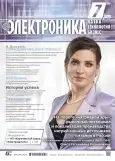Deep ultraviolet microscopy: principles and prospects of application in industry and science
- Authors: Plebanovich V.1, Grishkevich V.2
-
Affiliations:
- ОАО «Планар»
- ОАО «Оптоэлектронные системы»
- Issue: No 7 (2025)
- Pages: 120-124
- Section: Reliability and validation
- URL: https://journals.eco-vector.com/1992-4178/article/view/690218
- DOI: https://doi.org/10.22184/1992-4178.2025.249.7.120.124
- ID: 690218
Cite item
Abstract
The article reviews the physical foundations and practice of application of DUV-microscopy. The development of laser technologies and the emergence of new sensors, modern optical materials opens the way to its widespread implementation in microelectronics, biomedicine and materials science.
Full Text
About the authors
V. Plebanovich
ОАО «Планар»
Author for correspondence.
Email: vpleba@planar.by
к.т.н.
Belarus, г. МинскV. Grishkevich
ОАО «Оптоэлектронные системы»
Email: marketing@optes.by
Belarus, г. Минск
References
- https://ru.wikipedia.org/wiki/
- Smith A. (2023). DUV Microscopy for Semiconductor Inspection // Nature Photonics.
- ZEISS Academy Microscopy, https://www.zeiss.com/
- Zhang L. (2022). Deep UV Imaging of Biomolecules Without Labeling // Science Advances.
- ОАО «Оптоэлектронные системы», https://www.optes.by/
Supplementary files
Supplementary Files
Action
1.
JATS XML
Download (70KB)
3.
Fig. 2. Airy diffraction patterns created by light from two point sources passing through a circular aperture, such as the pupil of the eye. Points that are far apart (left) or that meet the Rayleigh criterion (center) can be distinguished. Points closer than the Rayleigh criterion (right) are difficult to distinguish
Download (79KB)
Download (110KB)
5.
Fig. 4. GUF – high-resolution analytical complex operating in the ultraviolet region of the spectrum (λ = 248 nm)
Download (110KB)









